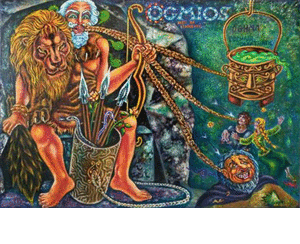DE GIRY Anne

My work involves the pursuit of several objectives:
- Realize compositions with complex structures, by subtle networks of lines which intersect and then express rays or light beams striking the objects which are there. Minerals, giant precious stones or landscape elements (for example the canvas chanson de cristal). The internal structure of these objects, even interior, proceeds however from the remainder of the composition as a whole.
- To obtain a beautiful pictorial material, Anne de Giry works in the old fashioned way by superimposing layers, dry, semi-dry, semi-oily to oily and numerous glazes. The artist sometimes incorporates sequins and glued papers or other elements.
-Finally, when characters invite themselves into the paintings, it is not their physical-corporal reality but the incarnation of a psychological, surreal or fantasy reality. The characters in the works of Anne de Giry express rather a feeling or an idea, rather than an allegory, a question or a state of being Anne draws many sketches and sketches of different sizes then proceeds by elimination in the choice of what she is going to paint when it comes to characters or anecdotal objects.
Anne de Giry graduated from the National School of Fine Arts in Paris in 1972, engraving section.
Bachelor's degree in arts and sciences, Censier/Sorbonne, 1972.
Master's degree in Art History and diploma of in-depth study, Panthéon/Sorbonne 1981.
Professor of Plastic Arts in the schools of the City of Paris, retired since 2007.
Celtic Mythology
Celtic mythology has the particularity of having only one divine feminine principle. In mythical literature and in toponymy, various important deities are its emanations.
As in Greek mythology (Jason and Medea, the matricide of Orestes, etc.), Celtic legends often recount the conflicts and tragedies resulting from the passage of matriarchy » to the patriarchy of « progrès », from maternal right (sexual and love freedom) to paternal right (marriage, virginity, and sexual repression). They bear witness to this nostalgia for an old bygone era, a paradise lost in the guise of the Faerie world, the Sidh (“ l’autre monde ”, ou monde spirits, for there is neither hell nor paradise among the pagans), parallel universe or under the waters, and beyond the oceans, kingdoms where the powerful fairies reign, marvelous islands of women, youth and abundance, where time and suffering are no more.
Fairyland is fundamentally matriarchal in essence. Evidenced by these many fairies and Ladies of the Lake (who gave the Sword to King Arthur), most often unmarried (supposed and said " vierges " like Diana -Artemis), who seduce and collect brave mortals. Woe to anyone who dares to reject the advances of these ladies. The lucky ones will be sent to " the other world ", during a hunt, pursuing a magical game, a supernatural white animal (doe, deer, wild boar… a totemic, heraldic, sacred animal), which will attract them through an invisible door of the Sidh, so that they relearn good love manners towards women.
The Celtic pantheon is populated by many goddesses such as Brigit, mother of all the gods. She reigns over the arts, war, magic and medicine. But also Dana, the primordial mother of the ancient Elven race of the Tuatha Dé Danann (son of Dana). They are heroes and magicians (Bansidh). They master druidism, lore and the arts. They came from wonderful islands in the north of the world, to reign over Ireland until the Aryan invasions of the Milesians (Celts who came from Spain in 500 BC).
Artist presented by the Art and Miss Gallery - Paris

